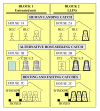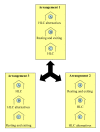Monitoring mosquitoes in urban Dar es Salaam: evaluation of resting boxes, window exit traps, CDC light traps, Ifakara tent traps and human landing catches
- PMID: 21418622
- PMCID: PMC3069960
- DOI: 10.1186/1756-3305-4-40
Monitoring mosquitoes in urban Dar es Salaam: evaluation of resting boxes, window exit traps, CDC light traps, Ifakara tent traps and human landing catches
Abstract
Background: Ifakara tent traps (ITT) are currently the only sufficiently sensitive, safe, affordable and practical method for routine monitoring host-seeking mosquito densities in Dar es Salaam. However, it is not clear whether ITT catches represent indoors or outdoors biting densities. ITT do not yield samples of resting, fed mosquitoes for blood meal analysis.
Methods: Outdoors mosquito sampling methods, namely human landing catch (HLC), ITT (Design B) and resting boxes (RB) were conducted in parallel with indoors sampling using HLC, Centers for Disease Control and Prevention miniature light traps (LT) and RB as well as window exit traps (WET) in urban Dar es Salaam, rotating them thirteen times through a 3 × 3 Latin Square experimental design replicated in four blocks of three houses. This study was conducted between 6th May and 2rd July 2008, during the main rainy season when mosquito biting densities reach their annual peak.
Results: The mean sensitivities of indoor RB, outdoor RB, WET, LT, ITT (Design B) and HLC placed outdoor relative to HLC placed indoor were 0.01, 0.005, 0.036, 0.052, 0.374, and 1.294 for Anopheles gambiae sensu lato (96% An. gambiae s.s and 4% An. arabiensis), respectively, and 0.017, 0.053, 0.125, 0.423, 0.372 and 1.140 for Culex spp, respectively. The ITT (Design B) catches correlated slightly better to indoor HLC (r(2) = 0.619, P < 0.001, r(2) = 0.231, P = 0.001) than outdoor HLC (r(2) = 0.423, P < 0.001, r(2) = 0.228, P = 0.001) for An. gambiae s.l. and Culex spp respectively but the taxonomic composition of mosquitoes caught by ITT does not match those of the indoor HLC (χ(2) = 607.408, degrees of freedom = 18, P < 0.001). The proportion of An. gambiae caught indoors was unaffected by the use of an LLIN in that house.
Conclusion: The RB, WET and LT are poor methods for surveillance of malaria vector densities in urban Dar es Salaam compared to ITT and HLC but there is still uncertainty over whether the ITT best reflects indoor or outdoor biting densities. The particular LLIN evaluated here failed to significantly reduce house entry by An. gambiae s.l. suggesting a negligible repellence effect.
Figures




References
-
- Geissbühler Y, Chaki P, Emidi B, Govella NJ, Shirima R, Mayagaya V, Mtasiwa D, Mshinda H, Fillinger U, Lindsay SW, Kannady K, Caldas de Castro M, Tanner M, Killeen GF. Interdependence of domestic malaria prevention measures and mosquito-human interactions in urban Dar es Salaam, Tanzania. Malar J. 2007;6:126. - PMC - PubMed
Publication types
MeSH terms
Grants and funding
LinkOut - more resources
Full Text Sources
Miscellaneous

